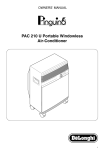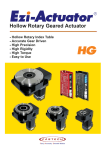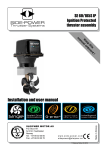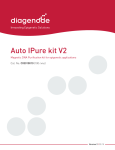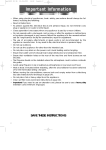Download KESSEL Grease Separator Euro “G” NS 1, 2 and 4 for underground
Transcript
INSTALLATION AND OPERATING INSTRUCTIONS KESSEL Grease Separator Euro “G” NS 1, 2 and 4 for underground installation KESSEL Grease Separator “G” according to EN 1825-1 Product advantages Euro-Norm 1825-1 certified Quick and easy assembly Compact / light 100% resistance against aggressive grease and soil acids Transport friendly Vertically adjustable upper section Subject totechnical amendment Illustration shows Euro-Norm separator and sampling chamber (load class D) The installation and service of this unit should be carried out by a licensed professional servicer Company -TelephoneNo. Edition 2009/12 stamp ID-Number. 010-614 1. Safety Precautions By installation, use, maintenance and repair of this unit please follow all appropriate DIN / VDE / DVGW safety precautionsandaccident prevention guidelines. Alsopleasefollowany local safety precautionsand accident prevention guidelinesestablished in your area. Also please observe the following: • BGV C22(formerly VBG37) • DIN 4124-Safety precautionsfor excavations/ trenches • DIN EN 1610-Standardproceduresfor theinstallation of drainagepiping BGR 117(formerly ZH1/77) -Standardproceduresfor workingin confinedspaces Donot allowany typeof wastewater intotheseparator which couldhinder theproper separation between oils/ fuelsandwater. ACCESS: NO SMOKING! Smoking is strictly prohibited near or around the separator at all times ! All sources of ignition or sparks are prohibited near or around the separator at all times ! SLIPPERY WHEN WET! Take caution when standing / walking near the separator. During disposal, cleaning and maintenance the surrounding area can become extremely slippery due to spilled oil / fuel. SEPARATOR AREA REGULATIONS: G No access of the separator for unauthorized personnel G The location of the separator should be chosen carefully as to allow sufficient access for maintenance, inspection, repair and disposal of the separator. G The wastewater in the separator can contain skin irritants. After coming in contact with wastewater or the separator itself, it is important to wash, clean and disinfect all skin and clothing which has been contaminated. G All personnel having anything to do with the separator should have a sound knowledge of the above safety precautions. Helpful Hints: 1. Manhole covers on top of fuel separators must not be screwed or locked on. 2. Manhole covers on top of fuel separators must not have ventilation ports. 3. All drains connected to the separator must not have any type of odour trap. 4. All drains connected to the separator should be equipped with sludge traps. 5. Wastewater must not be pumped into the separator, it must be gravity fed. 6. Detergents and cleaners used to clean the separator must not be emulsifiable, they should be cleaners which separate quickly with water (contact detergent / cleaner manufacturer for additional details). Table of contents 1. Safety precautions 2. General 5. Separator contents disposal 6. Maintenance 2 2.1 2.2 Application................................................................. Page Separator description ............................................... Page 4.1 4.2 Separator commissioning......................................... Page 10 Commissioning participants ..................................... Page 10 3. Installation 4. Commissioning ................................................................................. Page Installation ................................................................ Page 4 4 5 .............................................................................................. Page 11 .............................................................................................. Page 11 7. Replacement parts and accessories ............................................................................................ Page 12 8. Guarantee 9. Separator characteristics 10. Important contacts / info .............................................................................................. Page 13 .............................................................................................. Page 14 .............................................................................................. Page 15 Dear Customer, Before the KESSEL Euro Separator Version G is installed and placed in operation please carefully read and follow all of the instructions contained in this Installation, Maintenance and Userʼs Manual. Upon delivery of the Euro Separator please thoroughly inspect the separator to make sure that it has not been damaged during shipping. In case damage has occurred to the separator, please follow the instructions listed in the ‚Guaranteeʻ section of this userʼs manual. 3 2. General 2.1 Application 2.2 Separator description According to DIN 4040 and EN 1825, the installation of grease separators is required wherever oils and fats from animals and plants are introduced into waster water systems. Uncollected, oils and fats can cause serious damage to wastewater piping and private / public waste water treatment plants. The KESSEL Euro Grease Separator Version G consist of a grease separator with integrated sludge trap. The separator is constructed from Polyethylene (PE). Due to the smooth, wax like surface of the material Polyethylene, no additional protective coating is necessary. The separator is designed to be installed underground at a predetermined depth (below the frost level) and with the selected load class manhole cover (Class A, B or D). 4 3. Installation The KESSEL grease separator is delivered in ready for operation condition. If the separator consists of more than one container, each container will be packed separately on a pallet. Assembly material and accessories will also be packed on a pallet. In some circumstances the material and accessories will be inside one of the containers. When the shipment arrives, please inspect it immediately for damages which may have been caused during transport / shipping. The KESSEL Euro Grease Separator Version G should be installed underground as close as possible to the fixtures to which it is connected. In circumstances where it is not possible to install the separator in near proximity to the fixtures to which it is connected, the drainage piping (from fixtures to separator) should be equipped with heating elements. The inlet of the KESSEL Euro Grease Separator Version G must be installed below the frost level. This can be achieved by the use of the vertically adjustable upper sections. The manhole covers for the upper sections are lockable, odour tight and available in load classes A (1.5 ton), B (12.5 ton) and D (40.0 ton) and meet EN 124 standards. Installation 1. The excavation in which the separator is to be installed must be level and capable of handling the appropriate loads. 2. Place the separator in the prepared excavation hole. Make sure the separator rests at the appropriate level. Fill the separator with water to the outlet level. 3. The excavation should now be backfilled with non-binding material such as sand, gravel or process. Backfill only the main body of the separator, do not backfill around the upper sections. The backfill should be firmly compacted at incremental levels (approx 500 mm). For load class D (40.0 ton) situations, the upper section and manhole cover of the underground separator must be poured into a steel reinforced concrete apron for proper load support. Additional information regarding this load class D support is available from KESSEL. 4. Connect the inlet and outlet of the separator to the drainage piping. 5. No vertical pipes should be connected within one meter of the inlet of the separator. This one meter section (immediately prior to the inlet of the separator) serves as a wastewater calming section which hinders turbulence which can introduce unwanted oxygen and foam into the separator. All connections of vertical pipe (outside of the 1 meter calming section) should me connected to the main inlet pipe with two 45 degree fittings rather than one abrupt 90 degree fitting. 6. Install and adjust the upper section(s) of the separator to the desired level and secure with the included clamp ring (clamp ring will rest on the chamber itself). Final upper section level ad-justments can be made by manipulating the elevation adjustment screws located on the clamp ring 5 Watertightness test Before the separator is fully backfilled, the upper section and gasket must be tested for watertight-ness. To perform this test, insert inflatable closure balloons into the inlet and outlet of the separator and inflate to insure a tight seal. Fill the remainder of the separator with fresh water until the water level is toward the top of the upper section (where the manhole cover is placed). Check to make sure that there are no leaks. If there are no leaks, the inflatable closure balloons can be removed and the upper section can be backfilled and compacted. Note - When the outlet of the separator is to be installed below the sewer or wastewater piping level, a lifting station (based on DIN 1986 and prEN1825) must be installed. KESSEL offers a full line of lifting stations designed for this circumstance. Note - Underground separators to be installed below the groundwater table are available upon request. Note The KESSEL Euro Grease Separator Version G is designed for locations where: 1) Dispersion of odours during the emptying, cleaning or maintenance of the separator will not pose a problem. 2) Access of the disposal hose from the disposal truck to the separator will not pose a problem. 3. Installation 3.1 Installation Illustrations (Class B, 12.5 ton) Art.#. 93004/120D + 915880D Dimensioned drawing T = Installation Depth OD = Outer diameter Wastewater content 1 100 110 1380 1106 1050 h1 540 h2 610 Sludge trap 140 l Separator volume 230 l Grease storage 4 100 110 1380 1106 1550 1040 1110 400 l 370 l 160 l NS 2 DN 100 OD 110 a 1380 b 1106 Additional installation depths available upon request. h* 1300 790 860 200 l 370 l 120 l 6 70 l 3. Installation Assembly TheKESSEL separator isshippedfully assembledandready for operation. Eachchamber isshippedon an individual pallet. Accessories may either bepacked alongsidetheseparator or possibly bestored insideaseparator tank. Notice: Separatorsarepackaged and shipped upsidedown dueto theheavy weight of thecast iron manholecover. Takecaution when unpacking theseparators. Theseseparatorscan beeasilydissassembledif required. In order to re-assembletheseparator pleasefollowthesesteps: NS1 and NS2 Separator 1. Placeseparator basesection on floor (seeAbb1). 2. Placethelargesealinggasket insidetherecessed area. After gasket isinstalledlubricatetheupper visual portion of thegasket only (seeAbb2). 3. Place sludge trap in the appropriate location in the base section (seeAbb3). 4. Placesludgetrap overflowin thedirection of theoutlet of theseparator (seeAbb4). 5. Lower topsection of separator ontothebasesection until slotson topsection insert intoslotson basesection (seeAbb5). Makesure that thelubricated seal on thebasesection iscompletely inserted intotherecessedgasket areaof thetopsection. 6. Connect thetopandbasesection together with theprovidedclips asillustrated(seeAbb6a/b/c). Placetheoutlet pipeintotheseparator throughtheopeningon thetopsection until thebasefitsinto the guide slot at the base of the separator. Lubricated the gasket andconnect outlet pipewith outlet (seeAbb7). Insert sealinggasket intorecessedholeof topsection. Lubricatethevisibleportion of thegasket and then insert upper section with cast iron manholecover intotopsection of separator. 1. Placeseparator basesection on floor (seeAbb1). 7 2.NS4 Placethelargesealinggasket insidetherecessed area. After gasSeparator ket is installed lubricate the upper visual portion of the gasket only. Takecautionthat theNS4separatorsaremadeupwithchamber section with different diameters. Besurethat theproper sized sealinggasket isused with thecorrespondingsized chamber section (seeAbb2). 3. Connect thetopandbasesection together with theprovidedclips asillustrated(seeAbb6a/b/c). 4. Placetheoutlet pipeintotheseparator throughtheopeningon the top section until thebasefitsinto theguideslot at thebaseof the separator. Lubricatedthegasket andconnect outlet pipewith outlet (seeAbb7). Insert sealinggasket intorecessedholeof topsection. Lubricate the visible portion of the gasket and then insert upper section with cast iron manholecover into top section of separator. 6. Connect two chamber tankswith another with the supplied coupling(seeAbb9) 3. Installation A-A A A 햲 햳 햴 햵 햶 max. 7 Nm 6a 쎻 6b 쎻 6c 쎻 햸 8 3. Installation Installation Illustrations (Class D) 15 cm thick concrete load support plate 6-8 cm support layer 햲 KESSEL-Grease Separator G NS 2 4 cm Asphalt INLET 햲 Sludge trap 햳 Grease separation area 햴 Upper section with cover (load clas B/D) OUTLET Earth Earth 5-10 cm sand 30 cm gravel/process 0/32 compacted Illustration shows NS 2 Dimensions in cm Dimensioned Drawing NS 1 und NS 2 햲 Inlet 햳 Outlet 햴 Sludge trap 햵 Grease separation area 햶 Upper section with cover (load clas B/D) NS 1 2 DN 100 100 a 1055 1355 b 1020 1300 h1 1020 1136 9 h2 1120 1236 h3 650 750 h4 720 750 wastewater content Sludge trap Grease Storage 120 l 405 l 200 l 935 l Weight ca. kg 145 kg 195 kg 3. Installation Dimensioned Drawing NS 4 햲 Inlet 햳 Outlet 햴 Sludge trap 햵 Grease separation area 햶 Upper section with cover (load clas B/D) 햷 Chamber connection 4. Commissioning 4.1 Separator commissioning Beforetheseparator isput intoservicepleasemakesurethat: -Theseparator iscompletely clean, includinginlet and outlet, and that theinterior of thechamber isfreeof dirt anddebris. -Thecleaned separator iscompletely filled with clean cold water up to theoutlet. -Separator tobecheckedfor watertightnessandfor proper functionality -Contentsof thisuser’smanualstobediscussedwith thosepresent 4) Transfer of thismanual totheappropriatepersonnel 4.2 Commissioningparticipants Thecommissioningof theseparator isusually handled by a tradesman although this can be handled by a KESSEL contractor or KESSEL employeeif desired. 1) Thefollowingpeopleshouldbeon handduringthecommissioning: Buildingcontractor representative Plumber / tradesman whowill bemaintainingtheseparator Buildingmaintenancepersonnel Disposal company whowill behandlingthedisposal account 2) Commissioningpreparation Separator iscompletely filledwith clean water 3) Commissioning 10 5. Separator contents disposal Thefirst emptying(disposal) of theseparator contentsshouldtakeplace within 2to3weeksfrom theday theseparator wasplacedintoservice. Disposal intervals Accordingto DIN V 4040-2, it isadvised that sludgeand greaseseparatorsshould befully emptied, cleaned and refilled with cold fresh water at fourteen day intervals or at least on a monthly basis. In order for a greaseseparator tofunction asdesigned, it isveryimportant that theseparator isemptiedat regular intervalsasdescribedabove. Duetothis, it isrecommendedthat alicenseddisposal companyiscontractedtoempty theseparator at regular intervalsand duringtimeswhen strongodours will not present aproblem. •Placedisposal truck’ssuction hoseinsideseparator and removeentire contectsof chamber. •Rinseandclean interior wallsof chamber. Removecoagulatedfat/oil anddebris. •Refill chamber with coldclean water. •Clean andgreaseall accessibleseals. Replacesealsif necessary. •Replacecover(s) andsecurewith cover clamps. Disposal procedure •Removemanholecover. 6. Maintenance Maintenance of the separator Please make sure that: The separator should be tested to make sure that it is completely watertight before it is placed into operation and also during periodic intervals thereafter. 1. This Installation, Service and Maintenance Guide and any other documentation relating to the separator is kept in a safe place accessible to all who work on the unit. 2. Disposal of the contents of the separator follows the exact guidelines stated in this guide. 3. The disposal of the separator is carried out by a qualified, licensed company. 1. Surface care - the interior walls of the separator should be cleaned and checked for problems at regular intervals. 2. The separator should be thoroughly checked two times per year. During these inspections the separator should be completely emptied and thoroughly cleaned. The interior walls of the separator, as well as the exterior walls, should be cleaned and checked for damage every time the separator contents are disposed. It is recommended that a written log is kept for the separator. Documentation and information concerning all disposals and any other work done to the separator should be kept in this log for future reference. 11 7. Replacement parts and accessories KESSEL-Sampling Chamber B=400 for connection to separator systems For underground installation, free flowing sample availability. For installation depths T=…. DN 100 / 150 inlet / outlet (required size cut off on-site), connection to SML pipe according to DIN 19522. Sampling chamber internal diameter 400mm, vertically adjustable upper section with Load Class A, B or D covers, odour tight, locked, inlet / outlet height difference – 120mm. Manufacturer: KESSEL. Installation height T (mm) *400-1300 1330-1660 1330-1660 Inlet DN 100/150 100 150 Outlet OD 110/160 110 160 Class A 915 880 A 915 813 A 915 823 A Art.No. Class B 915 880 B 915 813 B 915 823 B Class D 915 880 D 915 813 D 915 823 D * Neck portion of chamber can be sawed of on-site to reduce installation height (do not cut at recessed gasket area). Article Number 915402 for deeper installations KESSEL-Extension section for sampling chambers for deeper installation Max. extension height. 600 mm Manufacturer: KESSEL Art.No. - 915 402 KESSEL-Extension section for underground KESSEL separator systems, polyethylene material, includes gasket Extension height 512 mm 1012 mm 12 Art.No. 917 406 917 407 7. Replacement parts and accessories KESSEL-Sampling chamber Ø 1000 mm in polyethylene synthetic material, for separation systems, for underground installation Inlet and outlet Ø ..for synthetic material pipes in: PE-HD (according to DIN 19537); PVC (according to DIN V19534); PP or AS. Installation depths T=... mm in monolithic structure, water-tight, resistant to aggresive wastewater, with integrated access steps, with telescopically height-adjustable upper section made of polymer, sealed odortight with cover class B/D according to EN 124 in cast iron, incl. removal mechanism. Drop height 120 mm. Installation Inlet/ depthT (mm) Outlet 1180-1630 DN 100 1180-1630 DN 150 1180-1630 DN 200 fits separator Art.#. Class B NS 1,2 und 4 9151010 B NS 7 und 10 9151015 B NS 15, 20 und 9151020 B custom-made Calss D 9151010 D 9151015 D 9151020 D Other installation depths available on request 8. Guarantee 1. In the case that a KESSEL product is defective, KESSEL has the option of repairing or replacing the product. If the product remains defective after the second attempt to repair or replace the product or it is economically unfeasible to repair or replace the product, the customer has the right to cancel the order / contract or reduce payment accordingly. KESSEL must be notified immediately in writing of defects in a product. In the case that the defect is not visible or difficult to detect, KESSEL must be notified immediately in writing of the defect as soon as it is discovered. If the product is repaired or replaced, the newly repaired or replaced product shall receive a new warranty identical to that which the original (defective) product was granted. The term defective product refers only to the product or part needing repair or replacement and not necessarily to the entire product or unit. KESSEL products are warranted for a period of 24 month. This warranty period begins on the day the product is shipped form KESSEL to its customer. The warranty only applies to newly manufactured 13 products. Additional information can be found in section 377 and 378 of the HGB. In addition to the standard warranty, KESSEL offers an additional 20 year warranty on the polymer bodies of class I / II fuel separators, grease separators, inspection chambers, wastewater treatment systems and rainwater storage tanks. This additional warranty applies to the watertightness, usability and structural soundness of the product. A requirement of this additional warranty is that the product is properly installed and operated in accordance with the valid installation and user's manual as well as the corresponding norms / regulations. 2. Wear and tear on a product will not be considered a defect. Problems with products resulting from improper installation, handling or maintenance will also be considered a defect. 10.11.2009 9. Separator characteristics Bahnhofstr. 31 D-85101 Lenting Article _____________________________________________________________________________________ Type _____________________________________________________________________________________ Art.-# _____________________________ Ser.#. _______________________Year__________________________ EN ______________________________________________Approval___________________________________ l x w x h _____________________________________________________________________________________ Sludge trap volume l_____________________________Grease storage volume/l___________________________ Volume___________________________________________Material____________________________________ Control stamp______________________________________Weight_____________________________________ This unit has been checked for watertightness to be sure that it is fully operational before leaving the factory. Date Name of examiner 14 Important contacts / Info Separator Type: __________________________________________________________ Day / Hour __________________________________________________________ Project description /Building services supervisor __________________________________________________________ Address __________________________________________________________ Telephone / Fax __________________________________________________________ Builder __________________________________________________________ Address __________________________________________________________ Telephone / Fax __________________________________________________________ Planner __________________________________________________________ Address __________________________________________________________ Telephone / Fax __________________________________________________________ Contracted plumbing company __________________________________________________________ Address __________________________________________________________ Telephone / Fax __________________________________________________________ KESSEL-Commissions no.: System operator /owner __________________________________________________________ Address __________________________________________________________ Telephone / Fax __________________________________________________________ User __________________________________________________________ Address __________________________________________________________ Telephone / Fax __________________________________________________________ Person of delivery __________________________________________________________ Other remarks __________________________________________________________ The system operator, and those responsible, were present during the commissioning of this system. ____________________________ Place and date ____________________________ Signature owner 15 ____________________________ Signature user Everything for drainage Backwater valves and cleanouts Grease separators Polymer and Ecocast drains Oil/fuel and coalescence separators Volatile liquid traps Inspection chambers Lifting stations, pumps, warning and control units Rainwater management systems Custom projects for industrial applications
















